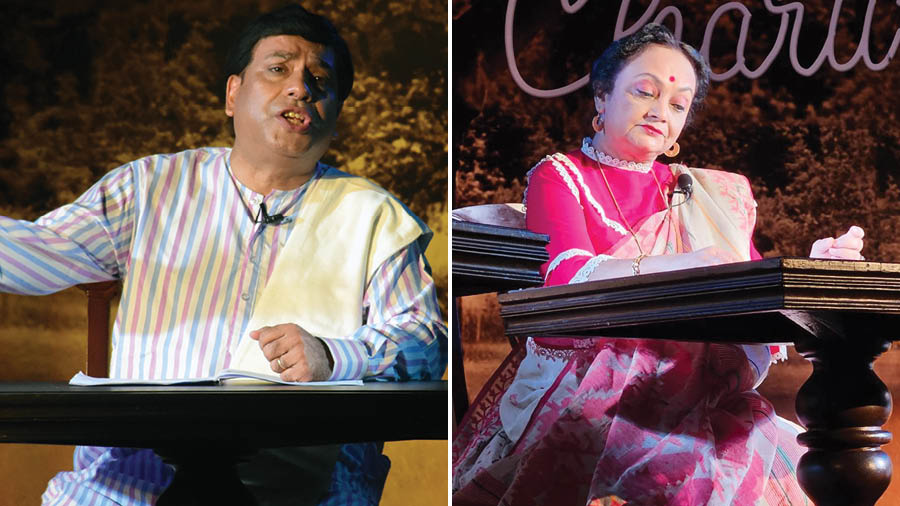Rabindranath Tagore’s Nashtanir, poignantly adapted to the screen by Satyajit Ray in the classic Charulata, has now inspired a dramatised play-reading in English — Charu’s Story transcreated by Sipra Bhattacharya and directed by Piali Ray.
First performed in Kolkata in June 2023, the overwhelming response prompted the team to take Charu’s Story to the national capital, where it will be staged on December 2 and 4.
Set against a colonial backdrop, with Westernisation making inroads into Bengal’s culture, Charu’s Story is a tale of love, marriage, betrayal and, most importantly, empowerment. It is a story where an educated woman like Charu develops her own individuality and comes into her own.
The cast includes Piali Ray, Pradip Mitra, Sumit Ray and Rajrupa Chakravarty.
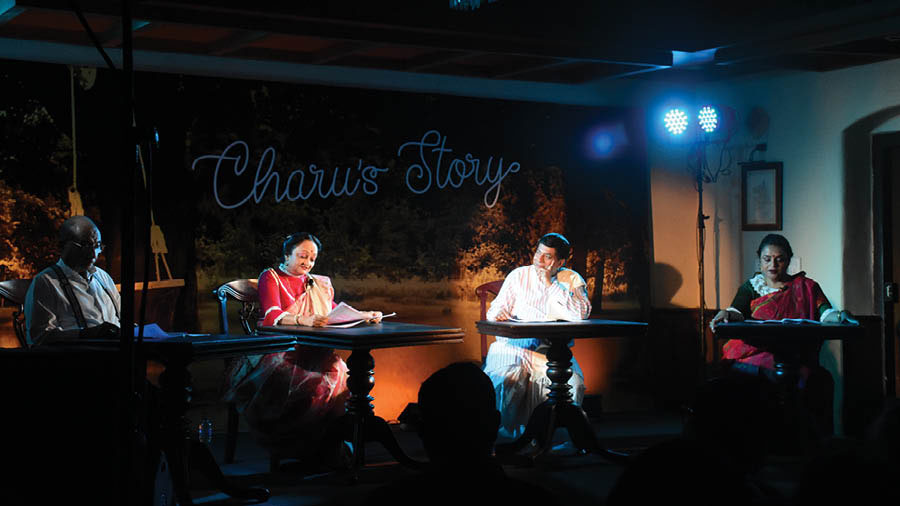
It was first staged in Kolkata on June 29 this year
The beginning
The project was born seven to eight years ago when Piali Ray realised the huge interest in Tagore among the Indian diaspora.
“I thought of taking up something in a way that would appeal to the non-Bengali- speaking audience as well. Many of Tagore’s works have already been translated into various other languages. I felt that there should be something which will be not just a translation but a performance too so that it evokes interest among the non-Bengali speaking audience,” said Ray, who approached her friend Sipra Bhattacharya, translator of several of Tagore’s works, to transcreate Tagore’s Nashtanir.
“I call it transcreation and not translation because in translation we translate a story to a story but here we have completely changed the format. I wanted her to write a script for a play in English based on the novella. Meetings after meetings and brainstorming followed and then we ended up with this format of a dramatised play reading. Sipra had not attempted transcreation before but she did a marvellous job. A lot of screenplays on Tagore’s works have been written before but a play script in English is a unique concept, I feel,” Ray said.
Armed with the script began the tough journey of finding a sponsor. “It was a tugh job as people were sceptical. And then with Covid, things came to a halt. Post-Covid, I took it up again and on June 29 this year, we staged the first show in Kolkata. I was very tense before the first show because the audience was primarily Bengali. But the response was positive and overwhelming, almost the entire audience came forward to congratulate us,” said Ray, who was cautious about retaining the original flavour of the story as she felt a slightest deviation from the original could create adverse reactions.
“It was an enthralling performance. The presentation, the set, music, costumes everything was very well-organised. The script along with the use of Rabindrasangeet was excellent,” said Dr Nandini Ray, who was in the audience
The play
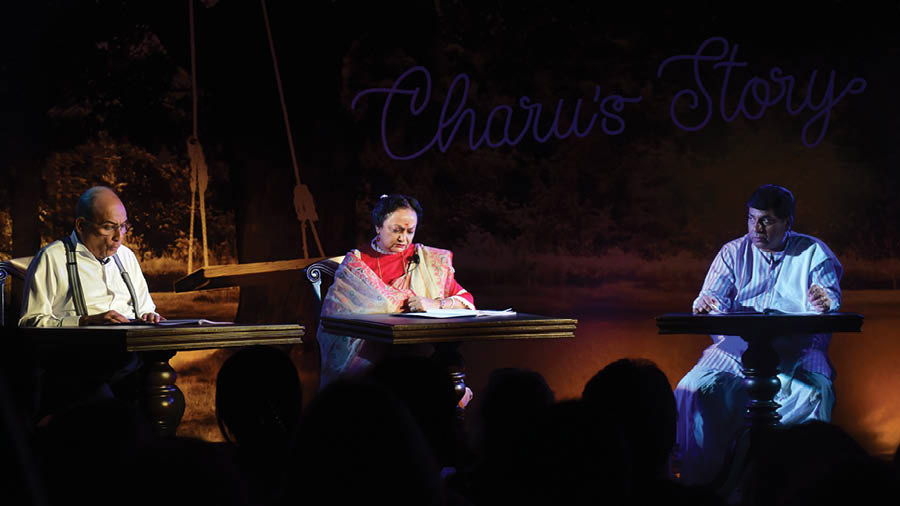
The period costumes take the audience back in time
The play revolves around four main characters — Charulata played by Piali Ray, Bhupati played by Pradip Mitra, Amal played by Sumit Ray and Manda played by Rajrupa Chakravarty.
Like the story itself, the play has at it heart the intricacies of relationships, the tensions that crop up, choice, empowerment and political consciousness.
“My first brief as the director of Charu’s Story to my cast was to retain the originality of the story and the finesse and subtlety of Tagore’s work. Everyone in the team has done a wonderful job. Though the story deals with a nexus of relationships, the script and the cast have underplayed everything. There is no melodrama in the play. Just like Sipra has tried to retain the time in her script, the backdrop designed by Sohini Gooptu and the costumes designed by me (with inspiration from Satyajit Ray’s Charulata) also depict the time that Tagore portrayed,” Ray said.
Speaking about the use of Rabindrasangeet in the play, Ray said: “In some scenes we have not used the song but the melody. In Kolkata, we played the songs in Bengali but for the upcoming shows in Delhi, where there will be non-Bengali audience, the lyrics will appear on a plasma screen in Roman script followed by the translation of the same.”
Cast speak
Piali Ray (Charulata and director of the play)
“Charulata is an intense character. She is educated, talented and an independent- thinking woman much ahead of her time. I have tried to keep her intensity as much as I could without putting up melodrama. Because I have always wanted to keep the originality of the story intact as a cast and also as the director.”
Pradip Mitra (Bhupati)
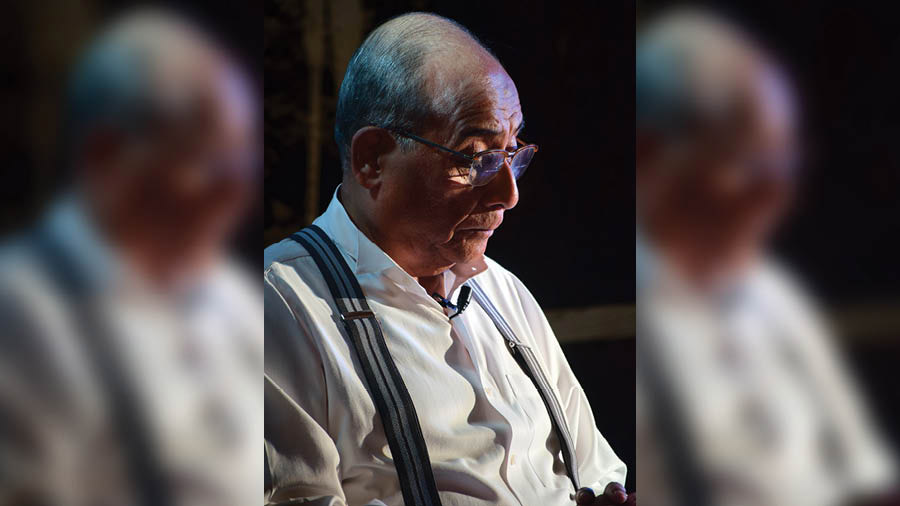
“My experience of playing the character of Bhupati has been wonderful. A certain image of Bhupati is already etched in the minds of the people from Shailen Mukherjee’s portrayal of the character in the movie Charulata. Bhupati is a quiet character. He is an erudite person with a deep interest in politics. For me, the characters of Charu and Bhupati to some extent are like chalk and cheese. But he is most certainly very fond of his wife in his own way though not the way Charu would like to get him to feel for her. I really enjoy playing this intense character. Though I have seen Satyajit Ray’s movie quite a few times, I have tried to keep my interpretation or presentation of Bhupati my own and people have appreciated it. I have acted on stage and in movies but this is a character I have fallen in love with. It’s different from the roles I have played in the past. The original story by Rabindranath Tagore has been beautifully transcreated by Sipra Bhattacharya. The script is excellent, too. I would like to make special mention of the use of Rabindrasangeet.”
Sumit Ray (Amal)
“It’s a very well-crafted script. I think what is very important for a dramatised reading is the emotion that comes through because we don’t have the flexibility to move on stage. To depict a certain time, the use of costumes and words like ‘Bouthan’, ‘Dada’ have been retained in the script. The Rabindrasangeet used after every scene has an impact on the audience. Amal’s character, which comes in as a breath of fresh air, the relationship that builds between Charu and Amal, the tension that builds — everything has to be emoted through voice and that is quite an experience. It’s just not reading but dramatised reading. The testimony of success of just not me or Amal’s character for all the four characters is that the shows we had, the audiences were absolutely spellbound. Not a whisper, not a movement for an hour. That is extremely gratifying. I am happy that it has come out so well.”
Rajrupa Chakravarty (Manda)
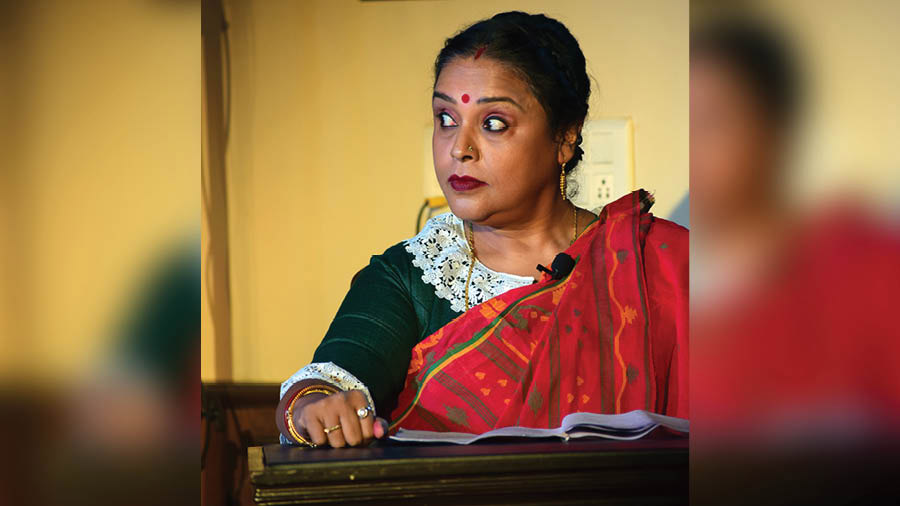
“The play was conceptualised by Pialidi some five to seven years ago. Right from the initial days she wanted me to be a part of the project and I was one of the first to be cast. This role holds a very special place in my heart. Though the role is brief, Manda plays a very important role. Charu’s character is extremely intense. Manda is like a relief with a tinge of naughtiness and flirtatious behaviour. It’s like a juxtaposition to Charu’s character. I really enjoy playing this character. The script has been written in such a way that each character is integrally woven in. The transcreation has been extremely well done by Sipradi. To retain the flavour of the original Bengali story was difficult but Sipradi did an outstanding job.”
The script
The visual experiences of the characters in Charulata are absent in Charu’s Story as it’s a reading presentation.
Sipra Bhattacharya had the tough job of keeping to the original while also ensuring a compact script that would not spill over an hour. “Tagore’s writings are full of reflections and observations. The story has layers of love, emancipation, and choice intertwined. To keep all this intact and write suitable dialogue was a tough job since there’s no visual representation. We could also not make the play too long as it would be difficult to hold the audience’s attention. So when I started to transcreate, my first aim was to make the story short while keeping the essence intact,” Bhattacharya said.
“Before taking up this script, I had translated some 25 different works of Tagore. So, I was familiar with Tagore’s work. It did help me to translate this story. But the biggest challenge about this translation was that it shouldn’t be bookish. It had to be contemporary with the elegance of Tagore’s language. I have not tampered the language. I have tried to use old words which people used in the 1960s. I have tried to keep all the layers in this translation. The four characters have their own flavour. Bhupati is an important contrasting figure to Charu and Amal. I also kept in mind that much of the audience would be non-Bengali,” she said.
Charu’s Story will be staged in partnership with India Habitat Centre, New Delhi, on December 2 and at Akshara Theatre, sponsored by ONGC, on December 4.
